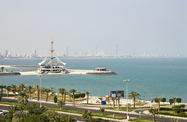A strong outlook for corporate earnings and the broader economy in Qatar, combined with an easing of restrictions on foreign ownership of firms, is pointing to a positive investment environment this year.
While many of the region’s larger oil producing countries will see GDP growth rates ease this year, Qatar’s relatively lower degree of reliance on hydrocarbons is giving impetus to investor confidence.
A recent report by Masraf Al Rayan Bank forecasts real GDP growth of 7.1% in 2015, in line with similar estimates for corporate earnings. Although oil and gas prices are likely to remain muted in the short-term, high levels of public spending on infrastructure and investment projects, underpinned by significant cash reserves built up over recent years, should help sustain growth and feed into private sector expansion, the report noted.
This figure tallies with estimates of 7% GDP growth this year, from Qatar National Bank (QNB), with the economy gaining further momentum in 2016 and 2017, where growth is forecast to rise by 7.5% and 7.9% respectively. “Qatar is well-positioned to withstand the temporary decline in oil prices due to its strong macroeconomic fundamentals,” QNB said in its latest “Economic Insight” report, published in March. “With substantial financial resources, Qatar has ample external and fiscal buffers to continue implementing its ambitious investment program.”
Earnings increase
Qatar’s corporate earnings are also expected to outperform the regional average this year, according to investment management firm Kuwait Financial Centre (Markaz). This builds on strong momentum from Qatari listed-companies in 2014, which was marked by several significant events including a move in August to change the rules on foreign ownership whereby international investors are able to acquire up to 49% of shares in traded Qatari corporations. Previously this had been capped at 25%.
According to Markaz, corporate earnings are likely to rise by 7.8% this year, building on the double-digit earnings growth recorded in the second half of 2014. This also represents a solid improvement on the overall 6% year-on-year growth rate for Qatar’s companies in 2014. In contrast, regional growth will fall short of the 10% growth recorded in 2014, reaching a forecast average of 5%, the report noted.
In capital markets last year, the successful Mesaieed Petrochemical Holding Company IPO raised some $881m for a 26% stake previously held by Qatar Petroleum – making this the country’s biggest IPO in five years. In 2015, many investors will be watching to see if further offerings are made, with Barwa Bank and Qatar First Bank widely reported to be keen to list.
In addition, Qatari banks are expected to have the highest return on equity (ROE) in the GCC this year according to Kuwait-based investment firm, Global Investment House. The ROE of the banks is estimated to reach about 18% in 2015, in comparison to a GCC average of 14%.
FDI support
Despite growth being fuelled by the non-hydrocarbon sector, more needs to be done to expand export diversification in the GCC countries, including Qatar, according to a recent report by the IMF. The fund noted that despite improvements in the environment for exporters in the GCC, intraregional trade remains limited. Based on available sector foreign direct investment (FDI) data, only 4% (in 2011) of FDI inflows to Qatar went to trade-related activity.
According to the latest official data, FDI in several major sectors accounted for 90% of all total inward investment at the end of December 2012. The Ministry of Development Planning and Statistics noted in a recent report that the mining and quarrying sector attracted the largest proportion of inward investment in 2012, followed by manufacturing and construction.
A report released by the UN Conference on Trade and Development at the end of March said that there had been a 4% year-on-year drop in FDI across the Middle East in 2014, in part as a result of increased regional instability, along with weaker oil prices. Qatar is no exception with inflows muted since the start of the decade, entering into negative territory in both 2011 and 2013, according to the UN’s “World Investment Report 2014”. Similar trends are seen in other GCC countries where persistent tensions in the region is cited for the reason behind a downward trend experienced since 2009.

